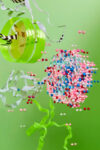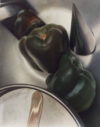At this point, we’re painfully (hopefully all) aware of the fact that plastic is not fantastic. But it can look intriguingly beautiful when captured by a skilled artist such as Alicja Wróblewska, whose compositions are visually stunning. The aesthetic side of her ongoing project is just a segway into a much more thought provoking message behind it. We’ve asked Alicja some questions about her work, her process, and how we (meaning commercial film/photography industry) can incorporate a more eco-friendly mindset in our own practices. Here’s what we found out.
How does the degradation of the environment influence your projects with time, in the grand scheme of things? How does your attitude towards them change, seeing as the materials that you work with are changing so dynamically?
Fortunately, ever since I started working on my environment-, consumption- and plastic-focused projects, a lot has changed in the world. While creating the Reef project, the European Parliament adopted a directive on limiting the impact of some artificial materials on the environment. Thanks to the enactment, plastic straws, utensils and disposable tableware, among others, slowly started to disappear from the market. It takes a lot of effort to find plastic straws nowadays. These are small steps, a drop in the ocean, but we have to start somewhere. Personally, I’m very glad to see these changes. After all, that’s why I do my projects – to get people to reflect on if we even need mass-produced plastic. I hope that one day, we will get on with the way of thinking that ruled before the capitalism’s boom and we’ll go back to buying drinks in glass bottles, we’ll get vegetables and fruit loose, not packed in plastic forms. Unfortunately, degradation of the environment will always take place to some degree; we can’t stop the industries or transport entirely; we’ll continue to produce waste and exploit Earth for her natural reserves. Therefore, sadly, I won’t ever be lacking a topic for my projects.
You’ve seemed to master the art of making something repulsive and uncomfortable look aesthetically pleasing, while remaining a valuable lesson on the pollution of our planet. Could you tell us a little bit more about this strategy? How do you make something look beautiful without glorifying it?
Contrary to popular belief, plastic waste, once you get rid of the labels, can become quite visually pleasing. We might not be able to see it as consumers, because the market has gotten us used to shapes, colours and keywords almost subliminally grabbing our attention. Plastic itself, as well as plastic wrappings of various products, are an effect of long-term studies of the consumers’ preferences, needs and likings. Plastic, colourful packaging holds a big dose of knowledge of human weaknesses, passions and nostalgia. Advertisement psychology is a fascinating field, and the pretty, tempting packaging are, regretfully, its result. Obviously, my goal wasn’t the aestheticization of plastic or waste in general. That being said, I don’t shy away from admitting that the plastic wrappings can be objectively pretty and eye-catching. From the kilograms of collected plastic, for my final sculptures I chose elements which were reminiscent of the real reefs or phytoplankton because of their colour, as well as those that would charm the viewer with their aesthetic. Art and advertisement are ruled (to some degree) by the same laws – they want to grab the viewer’s attention and introduce him to their world. A commercial wants to sell something, and art wants to tell a certain truth about the world. My strategy was to combine those two tactics in order to spread awareness of the critical issue that are the catastrophic levels of plastic waste on Earth. Plastic will never be the ‘main hero’ of a piece for me, it’s merely a tool (or rather a material), communicating an important problem.
What are some good habits that you think more production houses and film and photography studios should practice in order to make their work more eco-friendly?
It’s certainly important to pay attention to the usage of disposable products, especially the plastic ones. Another habit could be trying not to damage the terrain (e.g. lawns) while shooting, or explicitly limiting filming and photographing in areas not intended for commercial practices (forests, wildlife reserves – all the places where nature lives on its own). And the cherry on top would be to only work with clients, to whom caring for the environment is no stranger.
Alicja Wróblewska, visual artist, photographer. Her work is based on research and the use of interdisciplinary methods (sculpture, collage, photography). By using products of modern production (plastic and paper, mostly) she creates future organisms (like artificial/plastic coral reefs, phytoplankton, etc.) that could probably replace their natural equivalents.
Visit alicjawroblewska.com for more amazing projects or follow her explorations on Instagram: @alkawroblewska

















